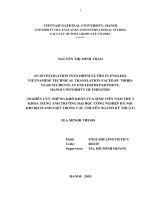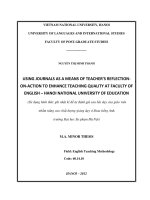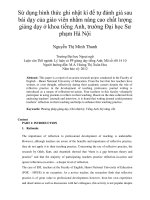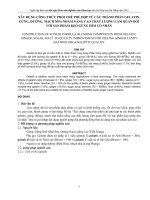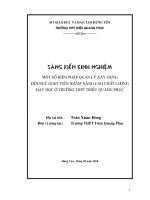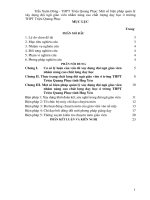Sử dụng hình thức ghi nhật kí để tự đánh giá sau bài dạy của giáo viên nhằm nâng cao chất lượng giảng dạy ở khoa tiếng Anh, trường Đại học Sư phạm Hà Nội
Bạn đang xem bản rút gọn của tài liệu. Xem và tải ngay bản đầy đủ của tài liệu tại đây (1.01 MB, 67 trang )
VIETNAM NATIONAL UNIVERSITY, HANOI
UNIVERSITY OF LANGUAGES AND INTERNATIONAL STUDIES
FACULTY OF POST-GRADUATE STUDIES
NGUYỄN THỊ MINH THANH
USING JOURNALS AS A MEANS OF TEACHER’S REFLECTION-ON-
ACTION TO ENHANCE TEACHING QUALITY AT FACULTY OF
ENGLISH – HANOI NATIONAL UNIVERSITY OF EDUCATION
(Sử dụng hình thức ghi nhật kí để tự đánh giá sau bài dạy
của giáo viên nhằm nâng cao chất lượng giảng dạy
ở khoa tiếng Anh, trường Đại học Sư phạm Hà Nội)
M.A. MINOR THESIS
Field: English Teaching Methodology
Code: 60.14.10
HANOI – 2012
VIETNAM NATIONAL UNIVERSITY, HANOI
UNIVERSITY OF LANGUAGES AND INTERNATIONAL STUDIES
FACULTY OF POST-GRADUATE STUDIES
NGUYỄN THỊ MINH THANH
USING JOURNALS AS A MEANS OF TEACHER’S REFLECTION-
ON-ACTION TO ENHANCE TEACHING QUALITY AT FACULTY OF
ENGLISH – HANOI NATIONAL UNIVERSITY OF EDUCATION
(Sử dụng hình thức ghi nhật kí để tự đánh giá sau bài dạy của giáo viên
nhằm nâng cao chất lượng giảng dạy ở khoa tiếng Anh,
trường Đại học Sư phạm Hà Nội)
M.A. MINOR THESIS
Field: English Teaching Methodology
Code: 60.14.10
HANOI – 2012
1
VIETNAM NATIONAL UNIVERSITY, HANOI
UNIVERSITY OF LANGUAGES AND INTERNATIONAL STUDIES
FACULTY OF POST-GRADUATE STUDIES
NGUYỄN THỊ MINH THANH
USING JOURNALS AS A MEANS OF TEACHER’S REFLECTION-
ON-ACTION TO ENHANCE TEACHING QUALITY AT FACULTY OF
ENGLISH – HANOI NATIONAL UNIVERSITY OF EDUCATION
(Sử dụng hình thức ghi nhật kí để tự đánh giá sau bài dạy của giáo viên
nhằm nâng cao chất lượng giảng dạy ở khoa tiếng Anh,
trường Đại học Sư phạm Hà Nội)
M.A. MINOR THESIS
Field: English Teaching Methodology
Code: 60.14.10
Supervisor: Dr. Hoàng Thị Xuân Hoa
HANOI – 2012
vi
TABLE OF CONTENTS
Page
DECLARATION i
ACKNOWLEDGMENTS ii
ABSTRACT iii
TABLE OF CONTENTS iv
PART I: INTRODUCTION
1. Rationale 1
2. Aims of the study 3
3. Scope of the study 3
4. Methods of the study 4
5. Significance of the study 4
6. Overview of the study 4
PART II: DEVELOPMENT
CHAPTER 1: THEORITICAL BACKGROUND
1. Reflective practice
1.1. Definition 6
1.2. Reflection procedure 8
1.3. Types of reflection 9
2. Journals as a means of reflection 10
2.1. Definition 10
2.2. Functions and advantages of journals 11
2.3. Focus of journal writing 13
vii
2.4. Analysis of journals 14
2.5. Prompts for journal entries 14
2.6. Guidelines for writing journals 16
CHAPTER 2: METHODOLOGY
1. Participants 18
2. Data collection instruments 18
2.1. Questionnaire 18
2.2. Interview 19
2.3. Journals 19
3. Research procedure 20
3.1. Problem identification 20
3.2. Preliminary investigation 21
3.3. Hypothesis 22
3.2. Intervention 22
CHAPTER 3: RESULTS AND DISCUSSION
1. Data analysis approach 24
2. Results of questionnaire 24
2.1. Teachers’ understanding of reflective practice 24
2.2. Teachers’ use of reflective practice 25
2.3. Teachers’ use of journals 26
3. Results of analyzing reflective journals 27
3.1. Participant 1 27
3.2. Participant 2 28
3.3. Participant 3 29
3.4. Participant 4 30
viii
4. Results of interview 33
4.1. Effectiveness of journal writing 33
42. Difficulties in reflection process 35
CHAPTER 4: FINDINGS AND IMPLICATIONS
1. Findings 38
2. Implications. 39
PART III: CONCLUSION
1. Conclusion 42
2. Limitations and suggestions for further study 42
REFERENCES 44
APPENDICES
1
PART I: INTRODUCTION
1. Rationale
Reflective practice has become a major focus in ESL/EFL teacher education
programs worldwide since it is undoubtedly beneficial and essential for
professional growth and more effective teaching. As cited in Maat and Zakaria
(2010), reflection has contributed to self improvement (Schon, 1983). This will lead
to the changes in teachers’ cognition and teaching practices (Cooney, Shealy &
Arnold, 1997, cited in Maat & Zakaria, 2010). According to Cohen and Hill (2000),
reflection can be used as a tool to investigate teaching practices in order to achieve
meaningful educational reform.
Some people may argue that experience is the key to professional growth as
teachers form routines and strategies to deal with recurring situations of teaching.
However, according to Parker (1984), research shows that “for many experienced
teachers, many classroom routines and strategies are applied almost automatically
and do not involve a great deal of conscious thought or reflection” (cited in Richard
and Lockhart, 1996, p.4). These researchers asserted that it is vital to examine
experience in a systematic way so that it can play a productive role. Sharing the
same viewpoint, Odeh, Kurt, and Atamtürk stated that reflective practice allows
teachers to “think about what, how and why they do it” and therefore “step out of
routine action and make adaptations to match the needs of the learners” (p.3).
Larrivee and Cooper (2006) also insisted that there are many reasons why teachers
should be reflective. One of the obvious reasons is that they have to cope with a
wide range of situations and make several decisions regarding their students. Being
reflective and critical will help them effectively deal with complexities of
classrooms. Another reason is that there are growing demands on teachers, which
may cause them to feel isolated. Systematic reflection could help teachers take
2
control of their teaching and feel self-confident. In addition, reflective practice
helps teachers avoid routines and promotes responsibility for their actions.
As can be seen, the importance of reflection to professional development of
teaching is undeniable. However, although teachers are aware of the benefits and
importance of reflective practice, they do not apply it to their teaching practice. The
fact that several procedures take place simultaneously during a lesson makes it
difficult for teachers to be aware of their own teaching mistakes in classrooms and
why they happen. This is illustrated by Richard and Lockart (1996) when he quoted
the comments by a number of teachers after watching their own videotaped
teaching:
I had no idea I did so much talking and didn’t let students practice.
My pacing was terrible. I didn't give students enough time to practice one task
before going on to another.
I did a bad job on the group work exercises. The students didn't understand what
they were supposed to do.
I seemed to ignore half the students in the class.
Concerning the use of reflective practice, the research by Odeh, Kurt, and Atamtürk
showed that “there is a gap between theory and practice” and that the majority of
participating teachers practice reflection-in-action and ignore reflection-on-action –
a deeper level of reflection.
The case of EFL teachers at the Faculty of English, Hanoi National University of
Education (FOE – HNUE) is no exception. As a novice teacher, the researcher finds
that reflective practice is of great value to professional development; however, from
her own experience and observation as well as discussions with her colleagues, this
activity is not popular despite the teachers’ awareness of its benefits. Reflection is
especially of great significance because teachers in this context are training
teachers-to-be, and it is stated by Scales that “Reflective teachers are more likely to
develop reflective learners. If we practice reflection we can more effectively
3
encourage learners to reflect on, analyze, evaluate, and improve their own
learning.” (p.14)
Due to the importance of reflective practice in professional self-development and
the above-mentioned current situation, it is desirable to introduce activities to
promote teachers’ reflection-on-action. In this action research, journal writing is
introduced as a means of reflection to hopefully enhance teachers’ reflective
practice and teaching quality.
1. Aims of the study
This study is an attempt to promote teacher’s reflection-on-action in FOE-HNUE
via the use of journal writing. It will investigate the effectiveness of this activity
and the teachers’ difficulties when using journals as a means of reflection-on-
action.
To fulfill this purpose, the study aims to answer the following question:
How effective is journal writing as a means of reflection-on-action effective
in promoting teaching quality as perceived by teachers?
2. Scope of the study
This study focuses on enhancing teachers’ reflection-on-action of teachers at FOE –
HNUE using journal writing. Within its scope, the research aims at justifying the
effectiveness of using this means of reflection as perceived by the participants and
investigating their difficulties in their reflective practice.
3. Methods of the study
This study is conducted as an action research because it aims at promoting teachers’
reflection-on-action within a certain context, namely the Faculty of English, Hanoi
National University of Education. In order to fulfill that aim, journal writing is
utilized by the participants. Interviews and teachers’ reflection journals are
employed in order to get data which are analyzed by qualitative method.
4
4. Significance of the study
This research provides an opportunity for the participants in the target context to
systematically reflect on their teaching, from which they can have their own
assessment of the effectiveness of journal writing as a means of reflection-on-action.
This will accordingly lead to their decision on whether to continue using journals in
their professional development process or not. In addition, the findings on teachers’
obstacles when using this means of reflection will hopefully help to improve the
effectiveness of this activity, which eventually aims at enhancing teachers’ self-
development and teaching quality.
5. Overview of the study
This paper is divided into the following main parts:
Part I: Introduction - presents the rationale, aims of study, research questions,
scope, method, significance, and organization of the study.
Part II: Development - this part is divided into 4 chapters as follows:
Chapter 1: Theoretical background – provides the theoretical framework of
reflective practice and journal writing.
Chapter 2: Methodology – describes the study population, the research design as
well as data gathering instruments.
Chapter 3: Results and discussion - analyses and discusses data
Chapter 4: Findings and implications - presents findings and implications.
Limitations and suggestions for further research are also provided.
Part III: Conclusion – gives summary of the research and limitations as well as
suggestions for further study.
5
PART II: DEVELOPMENT
CHAPTER 1: THEORETICAL BACKGROUND
1. Reflective practice
1.1. Definition
In teaching, reflective thinking, reflective inquiry, reflective teaching, reflection and
reflective practice are used more or less as synonyms. In this study, these terms are
understood interchangeably.
Since originated by John Dewey (1933), the concept of reflective practice has been
defined in many ways by various researchers. According to this educator, it is when
people face a complex situation and wonder what needs to be done that they begin to
reflect on that situation. He stated that the purpose of reflective practice is to direct the
teacher in taking actions and in making decisions. In order to clarify his ideas, Dewey
provided a distinction between routine actions and reflection actions, between
unsystematic thoughts and reflective thinking.
In Dewey’s view, teachers who act routinely react to circumstances without thinking
about the reasons or different alternatives. These teachers often take things for granted
and do not try to justify their teaching methods, resulting in limited numbers of
solutions. As a result, non-reflective teachers often fail to recognize problems, have
little motivation for improvement, and are therefore unlikely to fulfill their professional
potential. In contrast, reflective teachers do not follow habitual ways of teaching. They
spend time considering what happens in classroom and the consequences of their
actions with the aim of improving their performance. Reflective teachers engage
themselves in thoughtful consideration of dilemmas in their own teaching practice and
think about these dilemmas in relation to several factors and contexts.
This distinction between mere thinking and reflection is also emphasized by Scales
with a list of features of reflection in professional settings as follows:
6
Deliberate
Purposeful
Structured
About linking theory and practice
To do with learning
About change and development – becoming a reflective teacher
(
Dewey, as cited in Odeh, Kurt, and Atamtürk, finally came to the conclusion that
reflection “emancipates us from merely impulsive and routine activity enables us to
direct our activities with foresight and to plan according to ends-in-view, or purposes
of which we are aware. It enables us to act in deliberate and intentional fashion to
know what we are about when we act” (p.2)
Larrivee and Cooper (2006, p.4) cited different definitions for this concept by several
authors, some of which are as follows. Reflective practice is:
A process that helps teachers think about what happened, why it
happened, and what else could have been done to reach their goals
(Cruickshank & Applegate, 1981, p. 553).
The use of higher-level thinking, such as critical inquiry and
metacognition, which allow one to move beyond a focus on isolated facts or
data to perceive a broader context for understanding behavior and events
(Hatton & Smith, 1995, p.40).
A critical, questioning orientation and a deep commitment to the
discovery and analysis of information concerning the quality of a
professional’s designed action (Bright, 1996, p.165).
An ongoing process of examining and refining practice, variously
focused on the personal, pedagogical, curricular, intellectual, societal, and/or
7
ethical contexts associated with professional work (Cole & Knowles,
2000,p.2).
The thoughtful consideration and questioning of what we do, what works
and what doesn’t, and what premises and rationales underlie our teaching and
that of others (Hubball, Collins & Pratt, 2005, p.60).
While looking through all definitions above, there seems to be a consensus on the
concept of reflective practice. Reflection comes from teachers’ willingness to question
their own practice with the aim of enhancing their teaching and students’ learning. It is
a purposeful and systematic process that enables teachers to explore, contemplate and
analyze their experiences in classrooms which results in deep understanding and finally
guides the teachers in making decisions and taking actions to improve their
professional practice.
In order for reflection process to be productive, teachers ought to follow a certain
number of steps. These steps are going to be presented in the next part.
1.2. Reflection procedure
Different authors suggest different sets of steps that teachers should take when they
reflect on their teaching. Larrivee and Cooper (2006) proposed three steps, including 1)
Solitary reflection - thoughtful consideration of your actions and critical inquiry into
the impact of your own behavior keeps you alert to the consequences of your actions
on students, 2) Ongoing inquiry - unending questioning of the status quo and
conventional wisdom by seeking your own truth, and 3) Perpetual problem-solving-
solve the problem.
These steps correspond three questions given by by Driscoll and Teh (2001), namely
what? so what? and now what?. Similarly, LaBoskey (1993, p.30) suggested three
following steps:
8
1. problem definition: describe and analyze the structural features of an
educational situation, issue, or problem
2. means/ends analysis: gather and evaluate information as to the possible
sources of the dilemma under consideration and to generate multiple
alternative solutions and their potential implications
3. generalization: integrate all of the information into a tempered conclusion
about or solution for the problem identified
Andrew Green (2011) cited Dewey’s ideas, stating that reflective process incorporates
five stages, including problem, suggestions, reasoning, hypothesis and testing.
As can be seen, there are some variations among scholars’ suggestions; however, they
have some consensus. Rogers (2001) (as cited in Rossouw, 2009) identified four
commonalities among the theoretical approaches he explored. The first step is to
identify problem and make a decision to find a solution. Second, additional information
related to the problem is collected. This may involve “hypothesis and reasoning,
acquiring, organising, and examining information, making assumptions and drawing
conclusions” (p.28). Next, a plan and a decision are formed as a result of data
collection step; a new understanding or theory may be created. Finally, actions are
taken based on the reflective process so that teachers could test the new findings in
practice and generate new understanding of the phenomenon.
1.3. Types of reflection
Regarding types of reflection, Farrell (2008) stated that there are two main forms,
namely weak form and strong form. The former is when teachers “informally evaluate
various aspects of their professional expertise” (Wallace, 1991, p.292 as cited in
Farrell, 2008). According to this author, this form of informal reflection may not
improve teaching and instead can give unpleasant feelings and frustration to teachers.
In contrast, the strong form means systematic and critical reflection.
9
Similarly, Schön (1983) made the distinction between reflection-in-action and
reflection-on-action (cited in Maat & Zakaria, 2010). According to him, reflection-in-
action occurs during the activity; teachers observe their thinking and actions and the
activity may be reshaped and adapted in progress. It is said that this type of reflection is
temporary and easily forgotten. Reflection-on-action, on the other hand, takes place
after an activity – a retrospective thinking about an experience. This form of reflection
is considered to be more systematic and thorough. Van Manen (1991), as cited in
Larrivee (2006), noted that reflection-on-action is more systematic, thorough, and
effective than reflection-in-action since teachers have more time for reflection, and
they are not distracted by multiple tasks in the teaching process. Therefore, reflection-
on-action rather than reflection-in-action is the focus of this study.
2. Journals as a means of reflection
2.1. Definition
Journals are accounts of teaching experiences; it “records thoughts, feelings, issues and
concerns can provide both a window of the past and a gateway to the future” (Larrivee
and Cooper, 2006, p21).
Boud, Keogh and Walker (1985, p.19), as cited in Boud (2001, p.2), define journal as
“intellectual and affective activities in which individuals engage to explore their
experiences in order to lead to new understandings and appreciations”.
Similarly, it is stated that journals are written record of both “experiences of , and
feelings about planning, preparing and delivering teaching and learning” (Scales, p.16).
According to this author, journals contain not only “general accounts of learning
sessions” but also “critical incidents” which are more important since they provide the
“basis for learning and continuing professional development” (p.16)
Richards and Lockhart (1996), citing Bailey 1990, Porter et al. 1990, and Walker 1985,
suggested a procedure which consists of two steps for keeping a journal. The first step
10
is to spend five or ten minutes after a lesson making entries on a regular basis, such as
once or twice a week or every day. The second step is to review journals regularly in
order to realize what might have not been noticed in the writing step.
2.2. Functions and advantages of journals
Journal writing is a popular means of reflective practice and journal writing over time
helps teachers “develop the habit of reflection” (Yost, 1997, Yost, Forlanza-Bailey, &
Shaw, 1999, cited in Larrivee and Cooper, 2006, p.22).
According to Larrivee and Cooper (2006), journal writing is a systematic self-
reflection process since it enables teachers to become “more aware of what is going on
in both their inner and outer worlds” and promotes their self-discipline (p. 21). These
two authors clarified their points by listing the following functions that journal writing
can serve (p.21):
Looking more objectively at classroom behaviors
Naming issues and posing questions
Recording critical incidents
Identifying cause and effect relationships
Discovering habits of thought
Working through internal conflict
Seeing patterns of unsuccessful strategies overtime
Tracing life themes
Sharing the same viewpoint, Richards and Lockhart (1996) claimed that journal writing
“helps trigger insights about teaching” and functions as a “discovery process” in which
“events and ideas are recorded for the purpose of later reflection” (p.7).
In comparison with other modes of reflection, journal writing have certain advantages,
one of the most important of which is that it “provides access to the hidden affective
variables that greatly influence the way teachers teach and students learn” (Brock, Yu
11
and Wong, 1992, cited in Wallace, 1998, p.63). These authors also presented the
following advantages of journals:
1. They provide an effective means of variables that are important to individual
teachers and learners.
2. They serve as a means of generating questions and hypotheses about
teaching and learning processes.
3. They enhance awareness about the way a teacher teaches and a student
learns.
4. They are an excellent tool for reflection.
5. They are simple to conduct.
6. They provide a first-hand account of teaching and learning experiences.
7. They are the most natural form of classroom research in that no formal
correlations are tested and no outside observer enters the classroom dynamic.
8. They provide an on-going record of classroom events and teacher and
learner reflections.
9. They enable the researcher to relate classroom events and examine trends
emerging from the diaries.
10. They promote the development of reflective teaching.
(Brock, Yu and Wong, 1992, p. 295, cited in Wallace, 1998, p.63)
For the above-mentioned reasons, journal writing is adopted for this study as a means
of reflective practice.
2.3. Focus of journal writing as a means of reflection
In terms of the content of journal entries, there are a variety of topics from classroom
experiences.
Bartlett (1990, pp. 209 – 210) (cited in Richards and Lockhart, 1996, p.7) gave further
ideas about this issue, listing teachers’ routine and conscious actions in the classroom;
12
conversations with students; critical incidents in a lesson; teachers’ personal lives as
teachers; their beliefs about teaching; events outside the classroom that they think
influence our teaching; and their views about language teaching and learning as
examples.
It is noticeable that a very favorable option for focus of reflection is critical incidents.
Wallace (1998) considered critical incidents as “a way of reducing the burden of
diary/journal-keeping and also achieving focus” (p.64) Critical incidents are key
occurrences which are of significance or importance for the teacher. These either
positive or negative incidents are situations for learning and will lead to generalisable
ideas and solutions which are transferable to other groups and learning situations. The
most important thing to remember is that the teachers do not solely list the incidents;
they have to discover why the incidents were significant to them, how they reacted and
why, what are the options of reactions for them, and what the outcomes of those
reactions would have been.
On the other hand, it is possible for teachers to reflect generally on their teaching
process without a particular focus. This option of reflection offers “a source of ideas or
issues for further investigation” (Wallace, 1998, p.59). From this reflection, recurrent
patterns will emerge, leading to awareness of common features or problems that need
dealing with.
2.4. Analysis of journals
Journal writing only takes effect when the entries are analyzed. This point is made by
Kathleen Bailey (1992, p. 224 cited in Wallace, 1998, p.63) that “simply writing diary
entries does not yield the maximum potential benefit of the process. In order to really
learn from the record, the diarist should reread the journal entries and try to find the
patterns therein.”
13
Regarding this analysis, Wallace (1998, p.59) proposed two ways of analyzing field-
notes which could also be applied for journal entries as follows:
They can be scanned as a source of ideas or issues for further investigation.
Are there any recurrent concerns? Are there any common features or events?
Are there any ideas that could be followed through? Are there persistent
problems or themes that warrant more detailed observation and analysis?
The data may already be selective and focused on a particular issue (e.g.
questioning techniques, student interaction). Have you got enough data to
think your way to a solution?
2.5. Prompts for journal entries
In order to make the full use of journal writing, Ross (1990) suggested that questioning
prompts should be given to “stimulate greater awareness of personal values and
implicit theories of teaching” (cited in Larrivee and Cooper, 2006, p.22). Smyth (1991,
cited in Larrivee and Cooper, 2006), therefore, proposed a series of four questions,
respectively moving from description to meaning to confrontation to reconstruction, to
be a powerful tool for prompting higher-order reflection. The questions are:
(1) What do I do? Description
(2) What does it mean? Meaning
(3) How did I come to be like this? Confrontation
(4) How might I do things differently? Reconstruction
Similarly, Driscoll and Teh (2001) provided a three-question framework of reflection
along with “trigger questions” for each stage:
a. What? Description of the event
What happened?
What did I see/do?
b. So what? Analysis of the event
How did I feel at the time?
What were the effects of what I did (or did not do)?
14
c. Now what? Proposed actions following the event
What are the implications of what I have described and analyzed?
How can I modify my practice?
The model of reflection provided by Gibbs (1988) is considered to be the most
complete since it asks clear and specific conclusions and action plans. This model
consists of the following questions:
Description:
What happened? Don’t make judgements yet or try to draw conclusions; simply
describe.
Feelings:
What were your reactions and feelings? Again, don’t move on to analyzing these yet.
Evaluation:
What was good or bad about the experience? Make value judgements.
Analysis:
What sense can you make of the situation? Bring in ideas from outside the experience
to help you. What was really going on? Were different people’s experience similar or
different in important ways?
Conclusions (general):
What can be concluded, in a general sense, from these experiences and the analyses
you have undertaken?
Conclusions (specific):
What can be concluded about your own specific, unique, personal situation or way of
working?
What are you going to do differently in this type of situation next time? What steps are
you going to take on the basis of what you have learned?
It can be seen that the set of guidelines by Gibbs (1988) is the most detailed and
comprehensive and it comprises those by other authors above. Therefore, this model is
going to be adopted in this research.
2.6. Guidelines for writing journals
15
Regarding the use of journals as a means of reflective practice, there are some
guidelines and options for effective exploitation.
First, in terms of the time for journal writing, it is possible to write journals
immediately after a teaching event or at the end of the day. For the former option, it is
more advisable because then the teaching details are fresh in mind while in the latter,
there may be more free time for reflection.
Second, it is advisable to be regular in journal writing habits, especially in early days of
journal writing.
Third, it is advised that when starting to write, teachers should not spend too much time
thinking about it; instead, they had better let the writing flow and try to capture the
experience and critical incidents.
Another advice is that the writing style for journals should be free, spontaneous and
informal since it is a personal activity. Furthermore, the use of illustration such as
diagrams, drawings or other visual aids is encouraged.
Finally, teachers should review their journals regularly to see if there are any recurring
themes that they can choose for improvement and development. In addition, it is
beneficial to summarize their journals at the end of a period. This will not only show
their progress but also provide a basis for their professional development. In addition,
it is useful to highlight main ideas for summary and action plans.
16
CHAPTER 2: METHODOLOGY
1. Participants
This action research involves four female lecturers from the Faculty of English, Hanoi
National University of Education. These participants are chosen on a voluntary basis
since the basis of all reflection is a willingness to undertake the process and to value it
as a means of improvement and development. When the researcher presented her
research proposal at a research idea sharing session in her division and called for
voluntary participation, four teachers volunteered to take part in the study and agreed
to send their reflection journals to the researcher.
All of the participants are working at the division of language skill development;
however, each teacher is assigned to take charge of teaching different skills and course
books. These teachers are very young; their teaching experience ranges from 1 year to
6 years. Two participants have master degree while the other two are taking a master
course.
2. Data collection instruments
In this study, interviews and journals are employed as the instruments of data
collecting.
2.1. Questionnaire
Most of the items in the questionnaire (Appendix 1) are open-ended questions. The
questionnaire is divided into three main parts: the first part probes the participants’
general understanding of reflective practice; the second part investigates their current
use of reflective practice; and the last part asks about their use of journals as a means of
reflection.
17
The questions in the first and the last parts were designed based on the literature review
on reflective practice and journals as a means of reflection respectively. The second
part adopted questions on current reflective practice given by Wallace (1998, p.55).
Basing on the result of this questionnaire, the researcher had discussions with the
participants about relevant issues of the study to make sure that they understand the
aims of reflective practice, the procedure of reflection as well as the use of journals to
reflect on their teaching. In particular, the participants were also asked to choose the
focus of their reflection.
2.2. Interview
After ten weeks of reflection, a semi-structured interview (Appendix 2) was conducted
in order to investigate two issues, namely the teachers’ perception of the effectiveness
of reflective practice and their difficulties in doing this activity. The interview is semi-
structure in nature with some guided and follow-up questions. It not only gives the
interviewee “a degree of power and control over the course of the interview” but also
allows for great flexibility as well as rich information (Nguyen, 2008, p.51).
2.3. Journals
Another data collection instrument and also means of intervention is journals. In this
study, a guided journal format (Appendix 3) is designed for the participants to reflect
on their teaching. Since this was the first time the participants used journals for
reflective practice, a number of options for journal format were given to them to
choose so that it is convenient for them. After discussion, the format proposed by
Gibbs (1988) was adopted and adapted.
The guided journal (Appendix 3) includes two main parts; the first part is for
information about lesson details while the second part consists of five following items,
each of which is clarified with guided questions:
1. Description
18
In this part, teachers describe a significant event or a situation in their teaching.
2. Feelings
Teachers describe their reactions to the situation and how they felt about the situation
as well as the way they reacted.
3. Analysis & evaluation
Teachers analyze the effect of what they did or did not do and evaluate the
experience. In addition, they have to try to find out reasons for what happened.
4. Conclusions
From the analysis and evaluation, teachers find solutions for the problem or draw
conclusion about the implications of the event. In addition, personal teaching style
or features can be recognized.
5. Thoughts added during review
In this last item, teachers note down their thoughts or a new insight about the event
after reviewing their journals.
This use of guided journal sheet is in line with Larrivee and Cooper’s (2006, p.21)
statement that “reflection can be facilitated via guided prompts, structuring periodic
rereading of previous entries to search for any emerging patterns, and posing questions
in a nonjudgmental way as a means of creating ongoing dialogue”.
3. Research procedure
3.1. Problem identification
The researcher herself is a novice teacher. During her early teaching time, there were
some sessions in which other teachers came to observe her class. She found it
beneficial since her colleagues gave her valuable feedback on her teaching so that she
could improve her practice. However, she recognized that it was impossible to have
regular observation activities.
19
As a result, a question was raised: In what way can I myself gain understanding of my
own teaching for professional improvement?
3.2. Preliminary investigation
In the next step, the researcher reviewed literature and had discussions with her
colleagues in order to answer the question above. It turned out that colleague visits to
her class sessions were a form of reflective practice. It was also found out that teachers
could self-reflect on their own teaching in different ways. This is also asserted by
Richards and Lockhart (1996, p.3) that “while comments of a supervisor or other
outside visitor can be a useful source of information about one's teaching, teachers
themselves are in the best position to examine their own teaching.”
The researcher realized that normally she herself practices reflection, but it is arbitrary
during or after her teaching; this may take place when she is on her way home or
discusses with her colleague. Accordingly, another question was raised: How can this
reflection be more systematic and effective?
Thus, the next investigation was on self-reflective practice which was presented in the
literature review. Finally, she decided to choose journal writing as a means of
reflection-on-action for her own teaching practice, which she found very beneficial.
The researcher had a chance to present her investigation in a research idea sharing
session at her faculty. Some of her colleagues were interested in participating in the
study. Therefore, this study was proposed to investigate the effectiveness of journal
writing as a means of reflection-on-action as well as teachers’ obstacles when using it.
Before journals were used by the teacher as a means of reflection, a questionnaire was
distributed in order to gain an overview of the participants’ knowledge as well as
current use of reflective practice.
3.3. Hypothesis
20
It is hypothesized that journal writing is a useful means of promoting reflective practice
in the Faculty of English, Hanoi National University of Education.
With this hypothesis, the study was implemented so as to investigate its effectiveness
and teachers’ difficulties in this activity. In particular, it aims at answering the
following question:
How effective is journal writing as a means of reflection-on-action in
promoting teaching quality as perceived by teachers?
3.4. Intervention
After the preliminary investigation, the researcher had discussions with the participants
about the aims and procedure of the study. In addition, relevant issues related to
reflective practice and journal writing were made clear to the teachers in order to make
sure that they have a sound understanding required for productive participation.
Especially, guideline for writing journals (as presented in the theoretical background)
was presented to the participants. After that, the guided journal format was introduced
and each part in the format was explained and illustrated so that the participants could
know how to write a reflection journal.
The research took place during the first semester in the academic year 2011 – 2012
(from January to June). However, the study started late, thus it lasted for only 10 week
(from April to June). The teachers used the guided journal format to reflect on their
teaching every week. They did not write journals immediately after each lesson;
instead, they did it at home on the day they had classes. These journals were then sent
to the researcher as a source of data for analysis. When the teachers forgot to send the
journals or to write reflection journals, the researcher reminded them. After the study
finished, the participants were asked to revise their journals and discovered new
insights for their issues or identify their own recurrent teaching problems or strengths.


